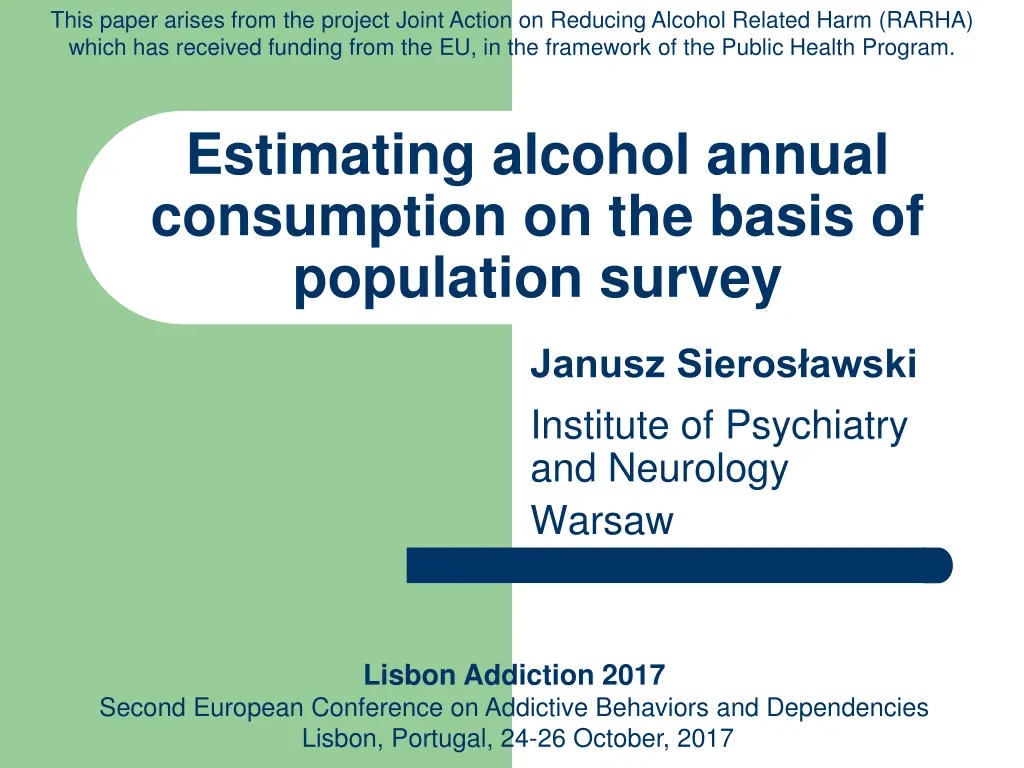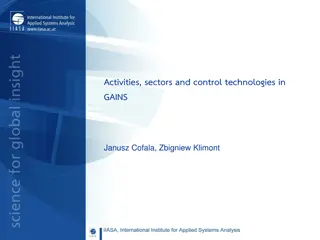
Understanding Alcohol Consumption Estimation Methods in Public Health Research
Explore the process of estimating annual alcohol consumption through population surveys, addressing issues of underestimation and adjustment techniques. Discover insights from the RARHA project and the SEAS RARHA Survey conducted across 19 European countries in 2015.
Uploaded on | 0 Views
Download Presentation

Please find below an Image/Link to download the presentation.
The content on the website is provided AS IS for your information and personal use only. It may not be sold, licensed, or shared on other websites without obtaining consent from the author. If you encounter any issues during the download, it is possible that the publisher has removed the file from their server.
You are allowed to download the files provided on this website for personal or commercial use, subject to the condition that they are used lawfully. All files are the property of their respective owners.
The content on the website is provided AS IS for your information and personal use only. It may not be sold, licensed, or shared on other websites without obtaining consent from the author.
E N D
Presentation Transcript
This paper arises from the project Joint Action on Reducing Alcohol Related Harm (RARHA) which has received funding from the EU, in the framework of the Public Health Program. Estimating alcohol annual consumption on the basis of population survey Janusz Sieros awski Institute of Psychiatry and Neurology Warsaw Lisbon Addiction 2017 Second European Conference on Addictive Behaviors and Dependencies Lisbon, Portugal, 24-26 October, 2017
Introduction Long tradition of measuring alcohol consumption by population survey Problem of huge underestimation of alcohol consumption comparing to sales statistics (30- 70% coverage) Variety of methods most commonly used Beverage Specific Quantity Frequency (BSQF) method Respondents report usual volume consumed on one occasion rather than an average volume
SEAS RARHA Survey European Alcohol Survey conducted in 19 Countries in 2015 in the scope of RARHA Project (Joint Action on Alcohol) Standardized methodology common questionnaire Representative random samples on average 1500 respondents per country In total above 32 000 interviews were collected
Estimating overall annual alcohol consumption with RSOD adjustment Assumption: Annual volume of usual alcohol consumption is estimated based on BSQF Annual volume of unusual binge consumption is estimated on the basis of RSOD Annual alcohol consumption calculated on the basis of BSQF after capping unrealistic values Adjustment applicable only for respondents with daily binge consumption lower than daily usual consumption
Adjustment of annual consumption Estimation of annual alcohol consumption using BSQF Questions on frequency of risky single occasion drinking (RSOD) in the past 12 months 40/60 grams of pure alcohol or more by one occasion (female/male) 80/120 grams of pure alcohol or more by one occasion (female/male) Question on maximal number of alcohol on one occasion in the past 12 months
Calculating alcohol consumption on the basis of RSOD RSOD consumption attributed to 40/60+ grams and 80/120+ grams estimated separately using formula frequency x quantity RSOD 40/60+ grams quantity: midpoint between 40/60 and 80/120 grams or if 80/120 grams not reported, between 40/60 and max number of grams RSOD 80/120+ grams quantity: midpoint between 80/120 grams and max number of grams Summing up both parts of the estimation
Estimating overall annual alcohol consumption with RSOD adjustment Calculating daily usual alcohol consumption dividing overall annual BSQF consumption by number of generic drinking days Calculating daily binge consumption dividing overall annual BSQF consumption by number of binge drinking days IF daily usual consumption lower than daily binge consumption, calculating adjustment by multiplying number of RSOD days per year by the difference be- tween binge (RSOD) consumption per binge drinking day and usual (BSQF) consumption per usual drinking day IF daily usual consumption equal to or higher than daily binge consumption adjustment not applied
Adjustment of annual alcohol consumption (liters of 100% alcohol) estimated on the basis of BSQF by RSOD data 12 RSOD adjustment BSQF 2.0 10 8 0.50.3 0.70.5 0.70.20.4 0.30.9 0.3 0.4 0.10.60.5 0.3 6 9.2 0.8 0.2 0.4 0.1 4 7.6 7.5 6.36.55.66.05.7 5.85.05.3 5.2 5.34.8 4.6 4.83.94.2 4.0 4.1 2 0
RSOD adjustment as a percent of BSQF estimate 25 21.421.0 20 18.6 15 12.112.011.811.2 8.97.87.16.95.9 5.9 5.75.44.83.93.22.92.4 10 5 0
Predictive value of estimates for prediction of alcohol problem BSQF Overall Area 0.700 0.707 Std. Error Sigif. 0.04 0.04 0.000 0.000 95% CI Lower 0.692 0.708 95% CI Upper 0.700 0.715
Conclusions Adjustment of annual alcohol consumption using the question on frequency of RSOD increases of estimate by 9% on average. In some countries like Bulgaria and Iceland increase by about 21%, while in other ones like Hungary, Italy, Lithuania, by 2% only Adjustment slightly increases predictive value of risk of alcohol related problems, but the difference is not significant The results of efforts to improve alcohol consumption estimation through population survey are not satisfactory yet

